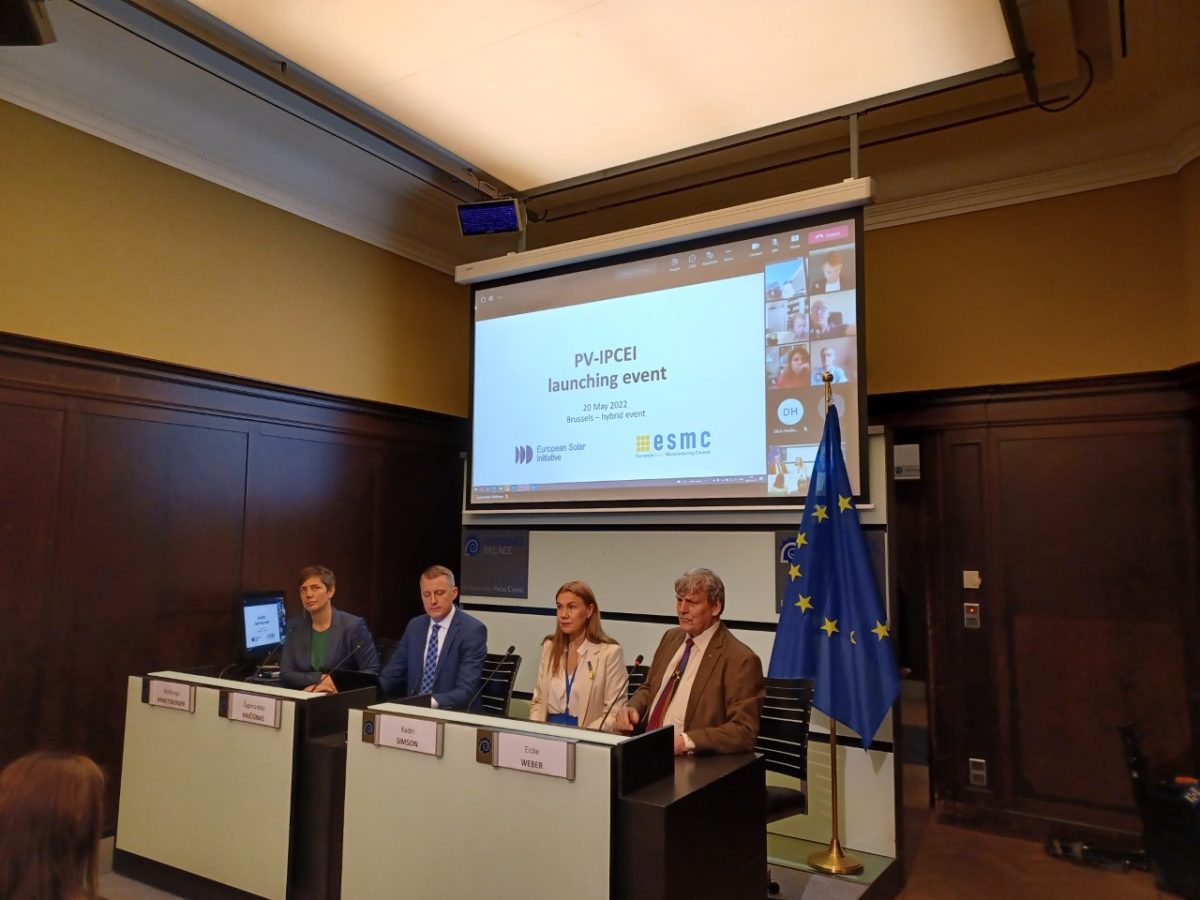Following only two days after the European Commission's (EC) landmark Solar Strategy on May 18, the mood of the PV-IPCEI event was one of renewed ambition and confidence. Europe's solar manufacturing industry wants to help the bloc disentangle itself from Russian fossil fuel reliance without immediately succumbing to another dependency on Chinese PV.
As SolarPower Europe CEO Walburga Hemetsberger put it to the small crowd in attendance and larger audience tuning in virtually: “Interesting times can lead to watershed moments. The RePower Initiative is just such a moment. Commissioner Kadri Simson has taken bold decisions which should lead to peaceful years built on renewables.”
Commissioner Simson, also in attendance, described the week as “extraordinary,” noting that reality is very different now than even six months ago now that Russia's actions have revealed them as “untrustworthy.”
“We are doubling down,” said Simson. “Before we focused on energy from the ground. Now we will look up to wind and sun … Citizens will move from consumers to prosumers … Necessity is driving us on. We want to reach 320 GW of newly installed solar by 2025. This represents an opportunity to hand power back to the citizens.”
Finally, Commissioner Simson said the newly bolstered European ambition “will be a game-changer,” particularly in terms of the new building solar PV mandate, an accelerated permitting process and, importantly, for manufacturing. “We are signaling demand for PV, and that represents an opportunity for supply … The future has always looked bright for solar. But now, thanks to circumstances outside our control, the future is here.”
Simson's rallying words were then seconded by Maive Rute, deputy director general for internal market, industry, entrepreneurship and SMEs. “Our aim is to build a strong value chain for the EU,” Rute said
It is a goal to be achieved through a strong project pipeline, an accelerated standardization process, and a competitive edge in innovation and sustainability which the PV-IPCEI should prove a valuable tool for in the hands of member states.
“It's all hands on deck for the implementation of the solar strategy,” Rute declared.
It is a notion supported by rare political accord behind the need for strong European PV manufacturing. As the Greens politician and Member of the European Parliament Michael Bloss related, whereas normally a speaker from the European Conservatives and Reformists (ECR Group) would disagree with everything, “(the ECR member) told me he agreed about the need for EU solar manufacturing. This is a first and a good sign.”
Though lacking representation from France and Germany, the launch was attended by representatives from Luxembourg, Austria, Spain, Poland and Lithuania. Joan Groizard, Spain's director general of the Institute for Diversification and Energy Savings, said the Iberian nation “is preparing to lead this PV-IPCEI” and the EU can “count on Spain for this initiative.”
Key projects
Although ostensibly a chance for the ESMC and potential PV-IPCEI projects to meet and gain insights into the IPCEI process of procuring state aid, those in attendance were also provided an overview of said projects. Among those which will seek to procure state aid through the PV-IPCEI process are a heterojunction cell and module production facility with a first-stage capacity of 300 MW, with plans to ramp to 3 GW and ultimately 15 GW by 2028.
MCPV's Marc Rechter spoke to the EU's lack of upstream strength, noting that the bloc needs scale. This is a huge opportunity to take advantage of Europe's “great knowledge in the next phase of PV tech … the tech jump is there.” Rechter also noted the need for short-term credit guarantees and the opportunity the EU has to set standards.
Similarly, machine supplier Singulus' Stefan Rinck said: “We are at the point to industrialize these new technologies. We have to build a pilot plant with new tech, to show that it works and we can then we can introduce industrial scale as soon as possible. It's available, but has to be tested in mass production.”
Other potential technological production projects focused on TOPCon (GIGA PV) industrializing Interdigitated Back Contact (IBC), which is largely based on PERC. Both of which emphasized innovative European solutions to reduce costs or improve sustainability.
Solitek's Julius Denafas presented a project for the mass production of integrated PV solutions, which is to say building integrated PV (BIPV), infrastructure integrated PV (IIPV), vehicle integrated PV (VIPV) and AgriPV. The project has capacity targets between 1 GW to 2.5 GW across the various integrated segments, though Denafras noted that BIPV manufacturers need standardization for scale. The potential mass production start date is penciled in for 2025.
Since sustainability is considered key to European manufacturing's competitive advantage, IFE's Sean Erik Foss and REC Solar's Trude Nysæter presented a circular PV project to strengthen the value chain for recycling PV modules. Foss noted the need for clean silicon and described current standards as insufficient.
“There is a lot of refined material which can remain refined if we're smart about it,” said Foss, noting that the suggested target would see recycling increase to 98% (volume) of annual waste.
The event concluded with a presentation and Q&A session with Demos Spartharis, head of unit for state aid at IPCEI's Environment and Innovation I, DG Competition and Marc Isabelle, founder and director of consultancy firm European Economics, which helps projects submit their proposals. Both Spatharis and Isabelle provided the example of the Battery PV-IPCEI and warned of mistakes and misadventures in the hydrogen IPCEI.
Among a litany of other requirements, for a project to be eligible for state aid, it requires a cross-border element including at least four member states. This shouldn't be a problem for PV, as evidenced by the five member states in attendance, though since funding ultimately comes from member states, Spatharis warned that the process moved as fast as the slowest state.
Half-jokingly, Spatharsis said that projects could follow the “Tesla Method” if they are in a rush, but noted that a project could only be considered for state aid if it started after submitting an aid proposal. “We want to push you to be better than the Chinese,” said Spatharis, “in terms of tech and price.”
This content is protected by copyright and may not be reused. If you want to cooperate with us and would like to reuse some of our content, please contact: editors@pv-magazine.com.




1 comment
By submitting this form you agree to pv magazine using your data for the purposes of publishing your comment.
Your personal data will only be disclosed or otherwise transmitted to third parties for the purposes of spam filtering or if this is necessary for technical maintenance of the website. Any other transfer to third parties will not take place unless this is justified on the basis of applicable data protection regulations or if pv magazine is legally obliged to do so.
You may revoke this consent at any time with effect for the future, in which case your personal data will be deleted immediately. Otherwise, your data will be deleted if pv magazine has processed your request or the purpose of data storage is fulfilled.
Further information on data privacy can be found in our Data Protection Policy.